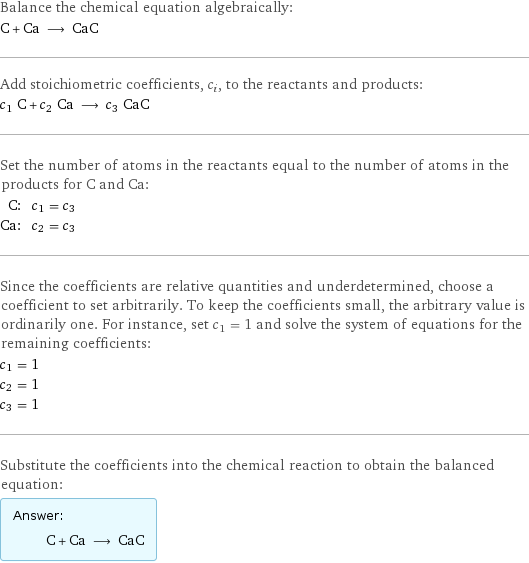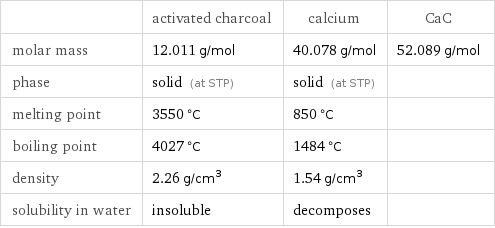Input interpretation

C activated charcoal + Ca calcium ⟶ CaC
Balanced equation

Balance the chemical equation algebraically: C + Ca ⟶ CaC Add stoichiometric coefficients, c_i, to the reactants and products: c_1 C + c_2 Ca ⟶ c_3 CaC Set the number of atoms in the reactants equal to the number of atoms in the products for C and Ca: C: | c_1 = c_3 Ca: | c_2 = c_3 Since the coefficients are relative quantities and underdetermined, choose a coefficient to set arbitrarily. To keep the coefficients small, the arbitrary value is ordinarily one. For instance, set c_1 = 1 and solve the system of equations for the remaining coefficients: c_1 = 1 c_2 = 1 c_3 = 1 Substitute the coefficients into the chemical reaction to obtain the balanced equation: Answer: | | C + Ca ⟶ CaC
Structures

+ ⟶ CaC
Names

activated charcoal + calcium ⟶ CaC
Equilibrium constant
![Construct the equilibrium constant, K, expression for: C + Ca ⟶ CaC Plan: • Balance the chemical equation. • Determine the stoichiometric numbers. • Assemble the activity expression for each chemical species. • Use the activity expressions to build the equilibrium constant expression. Write the balanced chemical equation: C + Ca ⟶ CaC Assign stoichiometric numbers, ν_i, using the stoichiometric coefficients, c_i, from the balanced chemical equation in the following manner: ν_i = -c_i for reactants and ν_i = c_i for products: chemical species | c_i | ν_i C | 1 | -1 Ca | 1 | -1 CaC | 1 | 1 Assemble the activity expressions accounting for the state of matter and ν_i: chemical species | c_i | ν_i | activity expression C | 1 | -1 | ([C])^(-1) Ca | 1 | -1 | ([Ca])^(-1) CaC | 1 | 1 | [CaC] The equilibrium constant symbol in the concentration basis is: K_c Mulitply the activity expressions to arrive at the K_c expression: Answer: | | K_c = ([C])^(-1) ([Ca])^(-1) [CaC] = ([CaC])/([C] [Ca])](../image_source/bdfa69785f55370ebbc5693ec6b67aed.png)
Construct the equilibrium constant, K, expression for: C + Ca ⟶ CaC Plan: • Balance the chemical equation. • Determine the stoichiometric numbers. • Assemble the activity expression for each chemical species. • Use the activity expressions to build the equilibrium constant expression. Write the balanced chemical equation: C + Ca ⟶ CaC Assign stoichiometric numbers, ν_i, using the stoichiometric coefficients, c_i, from the balanced chemical equation in the following manner: ν_i = -c_i for reactants and ν_i = c_i for products: chemical species | c_i | ν_i C | 1 | -1 Ca | 1 | -1 CaC | 1 | 1 Assemble the activity expressions accounting for the state of matter and ν_i: chemical species | c_i | ν_i | activity expression C | 1 | -1 | ([C])^(-1) Ca | 1 | -1 | ([Ca])^(-1) CaC | 1 | 1 | [CaC] The equilibrium constant symbol in the concentration basis is: K_c Mulitply the activity expressions to arrive at the K_c expression: Answer: | | K_c = ([C])^(-1) ([Ca])^(-1) [CaC] = ([CaC])/([C] [Ca])
Rate of reaction
![Construct the rate of reaction expression for: C + Ca ⟶ CaC Plan: • Balance the chemical equation. • Determine the stoichiometric numbers. • Assemble the rate term for each chemical species. • Write the rate of reaction expression. Write the balanced chemical equation: C + Ca ⟶ CaC Assign stoichiometric numbers, ν_i, using the stoichiometric coefficients, c_i, from the balanced chemical equation in the following manner: ν_i = -c_i for reactants and ν_i = c_i for products: chemical species | c_i | ν_i C | 1 | -1 Ca | 1 | -1 CaC | 1 | 1 The rate term for each chemical species, B_i, is 1/ν_i(Δ[B_i])/(Δt) where [B_i] is the amount concentration and t is time: chemical species | c_i | ν_i | rate term C | 1 | -1 | -(Δ[C])/(Δt) Ca | 1 | -1 | -(Δ[Ca])/(Δt) CaC | 1 | 1 | (Δ[CaC])/(Δt) (for infinitesimal rate of change, replace Δ with d) Set the rate terms equal to each other to arrive at the rate expression: Answer: | | rate = -(Δ[C])/(Δt) = -(Δ[Ca])/(Δt) = (Δ[CaC])/(Δt) (assuming constant volume and no accumulation of intermediates or side products)](../image_source/9ac6b29e60298a1231016df815197ac2.png)
Construct the rate of reaction expression for: C + Ca ⟶ CaC Plan: • Balance the chemical equation. • Determine the stoichiometric numbers. • Assemble the rate term for each chemical species. • Write the rate of reaction expression. Write the balanced chemical equation: C + Ca ⟶ CaC Assign stoichiometric numbers, ν_i, using the stoichiometric coefficients, c_i, from the balanced chemical equation in the following manner: ν_i = -c_i for reactants and ν_i = c_i for products: chemical species | c_i | ν_i C | 1 | -1 Ca | 1 | -1 CaC | 1 | 1 The rate term for each chemical species, B_i, is 1/ν_i(Δ[B_i])/(Δt) where [B_i] is the amount concentration and t is time: chemical species | c_i | ν_i | rate term C | 1 | -1 | -(Δ[C])/(Δt) Ca | 1 | -1 | -(Δ[Ca])/(Δt) CaC | 1 | 1 | (Δ[CaC])/(Δt) (for infinitesimal rate of change, replace Δ with d) Set the rate terms equal to each other to arrive at the rate expression: Answer: | | rate = -(Δ[C])/(Δt) = -(Δ[Ca])/(Δt) = (Δ[CaC])/(Δt) (assuming constant volume and no accumulation of intermediates or side products)
Chemical names and formulas

| activated charcoal | calcium | CaC formula | C | Ca | CaC Hill formula | C | Ca | CCa name | activated charcoal | calcium | IUPAC name | carbon | calcium |
Substance properties

| activated charcoal | calcium | CaC molar mass | 12.011 g/mol | 40.078 g/mol | 52.089 g/mol phase | solid (at STP) | solid (at STP) | melting point | 3550 °C | 850 °C | boiling point | 4027 °C | 1484 °C | density | 2.26 g/cm^3 | 1.54 g/cm^3 | solubility in water | insoluble | decomposes |
Units
